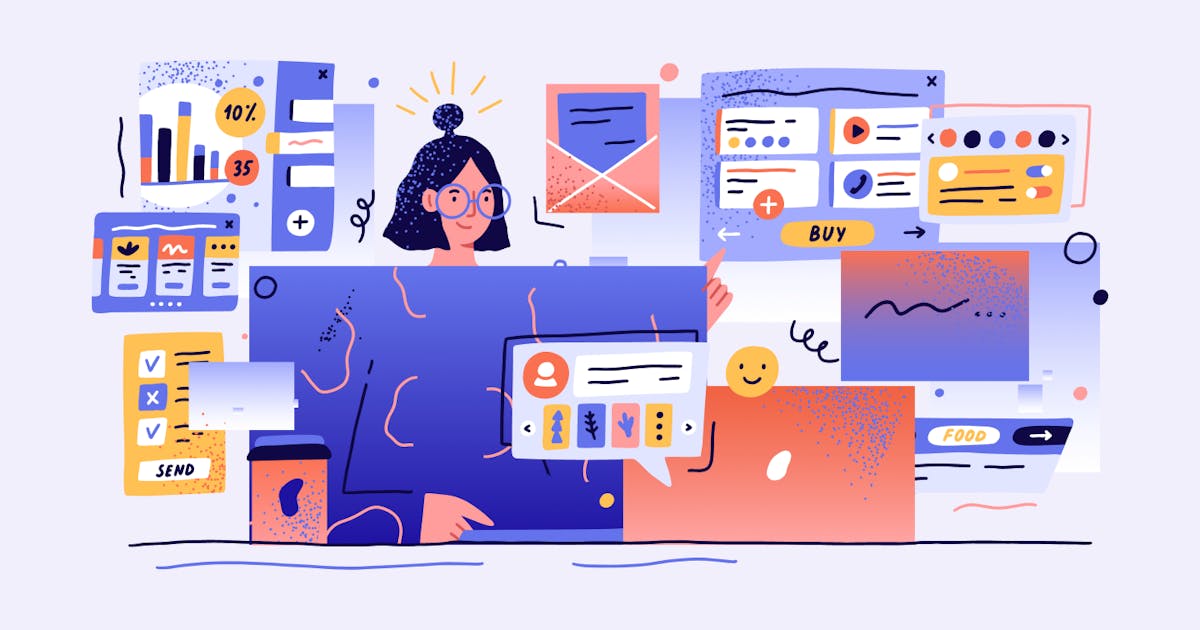The rapid pace at which companies adopted digital transformation to support remote work created a tool sprawl that is now leading to a data overload. With every employee and every action, a large volume of information is generated at a staggering pace while being distributed across multiple tools and silos. For managers and leaders, this sprawl has led to issues of tracking, dealing with noise, and low visibility into tools that are actually important and relevant, and as a result, it has become harder to draw insights from the digital exhaust.
Tip: Consider using workplace analytics tools that provide visibility into the IT tools that facilitate work in your organization. Stay cognizant of what tools your employees use and how you can optimize usage to meet your team’s goals.
Increased Focus But Siloed Work
Async work and the remote workplace have promoted productivity and focus work across teams and organizations. However, this work model has also propagated a larger disconnect amongst workers who don’t convene for work directly. An office water cooler was a space for social chatter within the workplace – connections were formed, news and interesting snippets from different teams were shared, and many strokes of serendipity gave rise to successful ideas. In remote work, an employee is cut off from learning about developments beyond their focus area. This leads to lower team cohesion and, more importantly, employees become disconnected from the larger vision and mission of a company.
Tip: Explore collaboration tools that emulate physical office chatter spaces such as Slack’s Donut or Gathertown that promote conversations across your organization. Virtual happy hours and remote team-building activities can set you up for success in breaking silos in your remote workplace.
Missing Opportunities to Help Teammates
Most successful projects are accomplished by teams that pitch in their strengths and experiences and help each other carry a project across the finish line. In the office of the past, this was done synchronously and in person. However, with remote work, teammates and managers are often obscured from the tasks and progress that the rest of the team works on. This makes it harder for members to be able to find opportunities to help their teammates.
Tip: Adopt project management and performance management tools that display the status of projects – what is being worked on, along with specs about skills and tools needed. Amplify the knowledge gained through project management with data correlation tools and analytics tools that provide insight on how teams are working. Creating an environment of knowledge sharing and teamwork equipped with such work analytics tools will allow a seamless cross-functional flow of work.
Threats to Well-Being
When managers do not get a thorough picture of their team’s efforts and challenges, it can be difficult to gauge which team members are faced with threats of stress, workload mismanagement, anxiety, or burnout. This can result in managers becoming incapable of offering the right resources and support for their teams to perform well and sustainably. For example, a remote dev team might have two or three senior developers who handle the bulk of review work in addition to their own coding tasks. These reviewers might be facing tight deadlines, leading them to work post regular work hours, in order to manage the other tasks required of them. Over time, this can lead to stress and burnout, and reflect poor quality of code. Similarly, some teams have only one or two team members working on incident management and other tasks. Such employees might be burdened with many context switches while struggling to focus on their core tasks. In these cases, managers and leaders need a factual viewpoint of their teams’ workload to gauge how best they can allocate work and support their teams. Leaders also need to stay cognizant of their teams’ well-being to ensure that their teams’ processes are sustainable and scalable.
Tip: Use the daily stand-up meeting to get visibility into the team members’ workload and potential blockers. Leaders should document and review these meetings to stay ahead of their teams’ performance trends and bottlenecks plan resources and work to help their teams succeed. Leaders can also use data-driven 1:1 meetings to discuss employee well-being and to gauge employee experience.
Importance of Visibility at Work
Visibility at work refers to the degree to which your work, accomplishments, and contributions are known and recognized by others, including your supervisors, colleagues, and stakeholders. It encompasses both your professional presence and the awareness of your skills, talents, and achievements within your organization.
The importance of visibility at work cannot be overstated. Here are several reasons why it is significant:
- Recognition and Advancement: When your work and accomplishments are visible to decision-makers, you have a higher chance of being recognized for your efforts. This recognition can lead to promotions, salary increases, and other professional opportunities. Visibility allows you to showcase your skills and expertise, increasing your chances of advancement within the organization.
- Building Trust and Credibility: Visibility establishes your professional presence and credibility among your peers and superiors. When others are aware of your contributions, they are more likely to trust your judgment, rely on your expertise, and seek your input on important projects or decisions. This can result in increased collaboration, responsibilities, and leadership opportunities.
- Networking and Collaboration: Increased visibility enhances your ability to network and collaborate with others. When people know about your work and achievements, they are more likely to approach you for partnerships, joint projects, or to seek your guidance. This expands your professional network, opens doors to new opportunities, and enables you to engage with a broader range of colleagues.
- Influence and Impact: Being visible at work allows you to have a greater impact on your organization. Your ideas, suggestions, and feedback carry more weight when you have a reputation for excellence and when decision-makers are aware of your contributions. This enables you to influence decisions, drive positive change, and have a meaningful impact on projects and initiatives.
- Personal Branding: Visibility helps you develop and strengthen your personal brand within your organization and industry. Your reputation is built upon the visibility of your skills, work ethic, and accomplishments. A strong personal brand can lead to increased professional opportunities, external recognition, and job security.
- Career Development and Learning: When your work is visible, you are more likely to receive feedback, mentoring, and support from others. Constructive feedback and guidance from supervisors and colleagues can help you improve your skills and performance, accelerating your career development. Additionally, increased visibility may expose you to new challenges and learning opportunities, expanding your knowledge and expertise.
It's important to note that visibility should be earned through quality work, effective communication, and active engagement rather than seeking attention for the sake of self-promotion. Building visibility requires consistent effort, professional conduct, and a focus on delivering value to your organization.
Overcome Visibility Challenges of Remote Work With Hatica
💡 Visibility is tricky, especially as we navigate remote and hybrid workspaces and use a multitude of tools to get work done. At Hatica, we believe that this problem is best solved with data analytics which is why we are building a work analytics platform to equip engineering teams with visibility into their workload, contributions, and processes to help them work effectively without burnout. Gain visibility into the teams and processes that power your workplace.







